We’ve explained in the past how the federal government puts a yellow smiley face on its unemployment figures by excluding Americans who have given up looking for work and including part-time workers as if they are fully employed.
Similarly, the Congressional Budget Office estimates the cost of a tax increase or tax reduction under the assumption that the increase will have no impact on taxpayer behavior – so tax cuts have no economic benefit and tax increases produce revenue without harming the economy.
So we shouldn’t be surprised that the Consumer Price Index (CPI), which measures inflation, rigs the numbers by excluding increases in the cost of food and energy.
The Federal Reserve Board’s $3.5 trillion in bond buying failed to boost inflation to the target rate of 2%, but the Fed could have accomplished its goal without buying a single bond. All it had to do was change the method used for calculating CPI.
The Fed vs. Reality
The small percentage of American consumers who have been following the Fed’s actions must have been perplexed. While the Fed has been worried about deflation, they’ve absorbed significant cost increases in everything from healthcare to mobile phones and cable services.
Granted, oil prices have fallen recently, but other prices are now increasing. In October, the CPI increased 0.2%, its largest increase in five months, after increasing 0.1% in September.
While we’ve noted that the Fed has not achieved its 2% goal, there is a lag time between Fed action and expected results. So one possibility now is that Fed action and economic improvements will combine to boost inflation much higher than 2%, after which the Fed can return to its previous goal of lowering inflation.
Current cost increases are coming at a time when the average American’s income has shrunk to 8% below what it was in 2007. As we’ve previously reported, the U.S. Census Bureau’s 2013 Income and Poverty Report found that real median household income has declined to the level it was at in 1994.
If the economy is finally improving, household income could increase, but so could inflation. Economic news remains mixed and much of the world is in a recession, but there have also been positive signs that the U.S. economy is recovering. The Labor Department reported that employers added 321,000 jobs in November, the biggest reported gain in nearly three years, while the Bureau of Economic Analysis claimed that the U.S. economy grew by 3.9% during the third quarter.
Going Backwards
As a result of price increases and falling income, a new study by The Wall Street Journal found that the middle class is “going backwards.”
Compiling data from 14,000 households earning between $18,000 and $95,000 a year before taxes – those who make up the middle 60% of the U.S. population — The Journal found that, “Overall spending for the group rose by about 2.3% over the six-year period from 2007, even as inflation totaled about 12%. At the same time, income for the group stagnated, rising less than half a percent.”
Health-care spending by middle-income Americans rose 42.1% between 2007 and 2013, the study found.
“That hit has been accompanied by increases in spending on other necessities, including food eaten at home, rent and education, as well as the soaring cost of staying connected digitally via cellphones and home Internet service.”
With costs increasing for essentials and new technology, and with incomes decreasing, spending on non-essential goods and services has decreased, the study found. Middle class Americans, whose spending is an essential driver of U.S. economic growth, are spending less on clothing, movies, concerts, amusement parks, restaurants, furniture and even child care.
The study “helps explain why so many retailers are turning in persistently lackluster results, and why the household-products business has shown virtually no growth for years. It also helps illuminate why the consumer-led U.S. economy has been so slow to rebound from the financial crisis.”
Consumer spending continues to make up just over two-thirds of the U.S. economy, but where the money is spent has shifted significantly.
Areas where spending increased include:
- Food, housing and healthcare combined accounted for 56% of consumer spending, up from 54% in 2007. Spending on food eaten at home increased 12.5%, while restaurant spending fell slightly.
- Transportation accounted for 19% of the total, which is about the same as in 2007, but a larger percentage was spent on gas and less was spent on auto-loan interest and new car payments.
- Spending on housing increased just 2.4%, but spending on rent increased 26%, as some families could no longer afford homes and moved into apartments. Reflecting lower home ownership and low interest rates, there were significant declines in spending on home purchases and mortgage interest.
- Electricity showed an 11% increase in spending.
Areas where spending decreased include:
- Event admission and fees, where spending fell 16.5%.
- A broad category that includes boats, motor-homes, cameras and party rentals, where spending fell a whopping 31%.
- Household textiles, including bath and bed linens, saw a 26.5% drop in spending.
- Spending on care for children and the elderly fell 25%; reflecting the higher unemployment rate, more parents cared for their young children and more children cared for their aging parents.
- Spending on new cars and trucks declined 6.5%, reflecting a shift to less expensive cars and used vehicles, as well as delayed purchases.
- For apparel, spending was down 11.5% overall, but down 18% for women 16 years of age and older.
As these shifts in spending demonstrate, the economy is ever changing. Changes in employment and demographics, regulatory changes, technological advances and other factors will always have a major impact on our quality of life and on where we spend our money.
